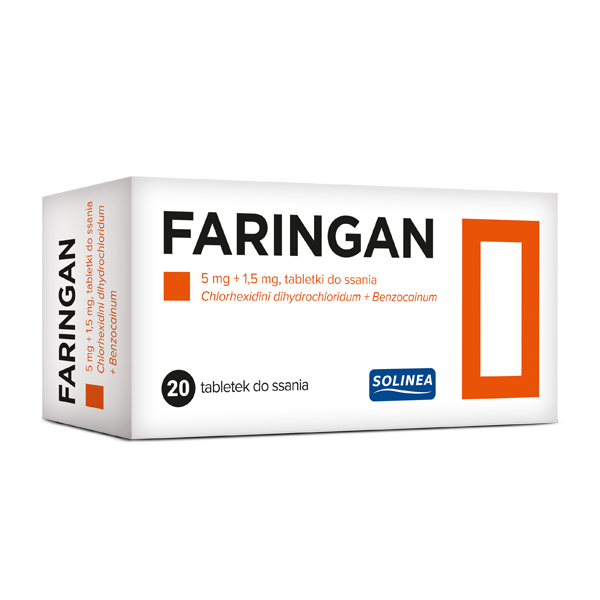

Faringan

Ask a doctor about a prescription for Faringan

How to use Faringan
Leaflet attached to the packaging: patient information
Faringan, 5 mg + 1.5 mg, lozenges
Chlorhexidine dihydrochloride + Benzocaine
Read the leaflet carefully before taking the medicine, as it contains important information for the patient.
This medicine should always be taken exactly as described in this patient leaflet or according to the doctor's or pharmacist's or nurse's instructions.
- Keep this leaflet, so you can read it again if you need to.
- If you need advice or additional information, consult a pharmacist.
- If the patient experiences any side effects, including any side effects not listed in this leaflet, they should tell their doctor or pharmacist or nurse. See section 4.
- If there is no improvement after 5 days or the patient feels worse, they should contact their doctor.
Table of contents of the leaflet
- 1. What is Faringan and what is it used for
- 2. Important information before taking Faringan
- 3. How to take Faringan
- 4. Possible side effects
- 5. How to store Faringan
- 6. Contents of the packaging and other information
1. What is Faringan and what is it used for
Faringan contains the active substances chlorhexidine and benzocaine.
Chlorhexidine has antibacterial effects. Benzocaine has a local anesthetic effect.
Faringan is indicated for the local treatment of inflammatory conditions of the oral mucosa (stomatitis, gingivitis, aphthous ulcers) and throat (pharyngitis) in adults and adolescents over 12 years of age.
In case of worsening symptoms of throat or gum pain, persistence of symptoms for more than 5 days, high fever, headache, nausea, or vomiting, consult a doctor.
2. Important information before taking Faringan
When not to take Faringan:
- if the patient is allergic to chlorhexidine, benzocaine, or any of the other ingredients of this medicine (listed in section 6).
- in patients with rare hereditary fructose intolerance.
- in patients with methemoglobinemia (a blood disease related to the formation of abnormal hemoglobin, unable to bind and transport oxygen. The most common symptom is cyanosis, resulting from tissue hypoxia).
- if the patient has wounds or ulcers in the mouth and throat.
- if the patient has low cholinesterase levels in the blood.
- in children under 12 years of age.
Warnings and precautions
Before starting Faringan, discuss it with your doctor or pharmacist.
Particular caution should be exercised in patients:
- with intolerance to ester-type local anesthetics (especially para-aminobenzoic acid (PABA) derivatives), parabens, or p-phenylenediamine, as they may be hypersensitive to benzocaine.
If the patient has erosive or desquamative changes in the oral mucosa, the medicine should be used with caution under medical supervision. During prolonged use (more than 7 days) of the medicine, reversible tooth discoloration and tongue surface discoloration may occur.
Children
Do not use in children under 12 years of age.
Faringan and other medicines
Tell your doctor or pharmacist about all medicines you are taking, have recently taken, or plan to take.
Avoid concurrent use of the medicine with other locally applied medicines.
Do not use the medicine with:
- other medicines containing bactericidal substances (e.g., sulfonamides);
- cholinesterase inhibitors (medicines used to treat cognitive disorders).
Faringan with food, drink, and alcohol
Do not eat or drink for 30 minutes after taking the medicine.
Pregnancy and breastfeeding
If you are pregnant or breastfeeding, think you may be pregnant, or plan to have a child, consult your doctor or pharmacist before taking this medicine.
Faringan should not be used in pregnant or breastfeeding women.
Driving and using machines
Faringan has no influence or negligible influence on the ability to drive and use machines.
Faringan contains aspartame (E 951), isomalt (E 953), and sodium.
Faringan contains aspartame (E 951) - 4 mg in each lozenge. Aspartame is a source of phenylalanine. It may be harmful to patients with phenylketonuria. This is a rare genetic disorder in which phenylalanine accumulates in the body due to its improper excretion.
The medicine contains isomalt (E 953) – 656.5 mg of isomalt (E 953) in each lozenge. If the patient has previously been diagnosed with intolerance to some sugars, they should consult their doctor before taking the medicine.
The medicine contains less than 1 mmol (23 mg) of sodium per lozenge, which means the medicine is considered "sodium-free".
3. How to take Faringan
This medicine should always be taken exactly as described in this patient leaflet or according to the doctor's or pharmacist's or nurse's instructions. If in doubt, consult your doctor or pharmacist or nurse.
Recommended dose
Adults and adolescents over 12 years of age
Suck one lozenge several times a day. If necessary, suck one lozenge every 1-2 hours, not exceeding 8 lozenges per day.
Method of administration
Start using the medicine when the first symptoms appear.
Suck the lozenges until they dissolve in the mouth. Do not swallow or chew.
For 30 minutes after taking the medicine, do not eat or drink. It is recommended to take the medicine at least 30 minutes after a meal and at least 30 minutes after brushing your teeth, before bedtime.
Chlorhexidine increases the formation of dental calculus, so during the use of the medicine, pay special attention to oral hygiene and consider using a toothpaste that prevents the formation of dental calculus.
If symptoms worsen or do not improve after 5 days of taking Faringan, or if high fever, headache, nausea, or vomiting occur, consult a doctor.
If you feel that the effect of the medicine is too strong or too weak, consult your doctor.
Use in children
Do not use Faringan in children under 12 years of age.
Using more than the recommended dose of Faringan
In case of taking a higher dose than recommended, consult your doctor or pharmacist immediately.
Missing a dose of Faringan
If a dose is missed, do not take a double dose to make up for the missed dose, but take it at the time resulting from the recommended dosing schedule.
In case of any further doubts about the use of this medicine, consult your doctor or pharmacist.
4. Possible side effects
Like all medicines, Faringan can cause side effects, although not everybody gets them.
Stop taking the medicine and consult your doctor or contact the emergency department of the nearest hospital immediately if you experience an allergic reaction and/or anaphylactic shock. Symptoms may include: rash, itching, fainting, swelling of the lips, face, throat, or tongue, difficulty swallowing or breathing.
The side effects that may occur when taking Faringan are listed below:
Rare (may occur in less than 1 in 1,000 people): allergic reactions, local irritation
Very rare (may occur in less than 1 in 10,000 people): hypersensitivity reactions, anaphylactic shock
Frequency not known (frequency cannot be estimated from the available data):
methemoglobinemia (a blood disease related to the formation of abnormal hemoglobin), tooth discoloration, tongue discoloration, burning sensation of the tongue, tingling of the tongue, and/or taste disorders during prolonged (more than a week) use.
Reporting side effects
If you experience any side effects, including any side effects not listed in this leaflet, tell your doctor or pharmacist or nurse. Side effects can be reported directly to the Department for Monitoring of Adverse Reactions to Medicinal Products of the Office for Registration of Medicinal Products, Medical Devices, and Biocidal Products: Al. Jerozolimskie 181C, 02-222 Warsaw,
tel.: 22 49-21-301, fax: 22 49-21-309, website: https://smz.ezdrowie.gov.pl.
Side effects can also be reported to the marketing authorization holder.
By reporting side effects, you can help provide more information on the safety of this medicine.
5. How to store Faringan
Keep the medicine out of sight and reach of children.
There are no special precautions for storing the medicine.
Do not use this medicine after the expiry date stated on the packaging after: "Expiry date (EXP):" or after: "EXP:". The expiry date refers to the last day of the specified month.
Medicines should not be disposed of via wastewater or household waste. Ask your pharmacist how to dispose of medicines that are no longer needed. This will help protect the environment.
6. Contents of the packaging and other information
What Faringan contains
- The active substances of Faringan are chlorhexidine dihydrochloride and benzocaine. Each lozenge contains 5 mg of chlorhexidine dihydrochloride and 1.5 mg of benzocaine.
- The other ingredients (excipients) are: isomalt (E953), macrogol 6000, peppermint flavor (menthol, menthone, peppermint oil, maltodextrin, sodium octenyl succinate (E 1450)), aspartame (E 951), magnesium stearate.
What Faringan looks like and contents of the packaging
Faringan is a white or almost white, flat, round lozenge with a dividing line on one side and a minty smell. The dividing line on the lozenge is only to facilitate breaking it, not to divide it into equal doses.
PVC/Aluminum blister pack containing 9 or 10 lozenges, in a cardboard box.
Package sizes: 10, 18, 20, 27 lozenges.
Not all package sizes may be marketed.
Marketing authorization holder and manufacturer
Marketing authorization holder
Solinea Sp. z o.o. Sp.K.
Elizówka 65
21-003 Ciecierzyn, Poland
Tel. 81 463-48-82
{logo of the marketing authorization holder}
Manufacturer:
Mako Pharma Sp. z o.o.
ul. Kolejowa 231A,
05-092 Dziekanów Polski
Poland
Date of last revision of the leaflet: 11.07.2022
- Country of registration
- Active substance
- Prescription requiredNo
- Manufacturer
- ImporterMako Pharma Sp. z o.o.
- This information is for reference only and does not constitute medical advice. Always consult a licensed doctor before taking any medication. Oladoctor is not responsible for medical decisions based on this content.
- Alternatives to FaringanDosage form: Aerosol, (2 mg + 0.5 mg)/mlActive substance: chlorhexidineManufacturer: Laboratoria Qualiphar N.V./S.A.Prescription not requiredDosage form: Tablets, 5 mg + 1 mgActive substance: chlorhexidinePrescription not requiredDosage form: Aerosol, (20 mg + 5 mg)/10 mlActive substance: chlorhexidineManufacturer: Qualiphar N.V/S.APrescription not required
Alternatives to Faringan in other countries
The best alternatives with the same active ingredient and therapeutic effect.
Alternative to Faringan in Spain
Alternative to Faringan in Ukraine
Online doctors for Faringan
Discuss dosage, side effects, interactions, contraindications, and prescription renewal for Faringan – subject to medical assessment and local rules.






